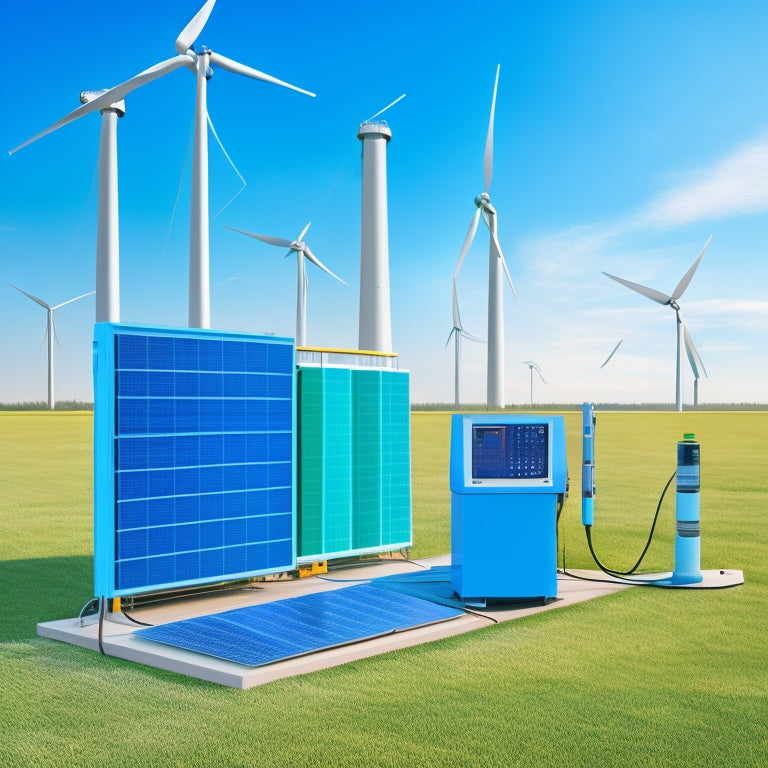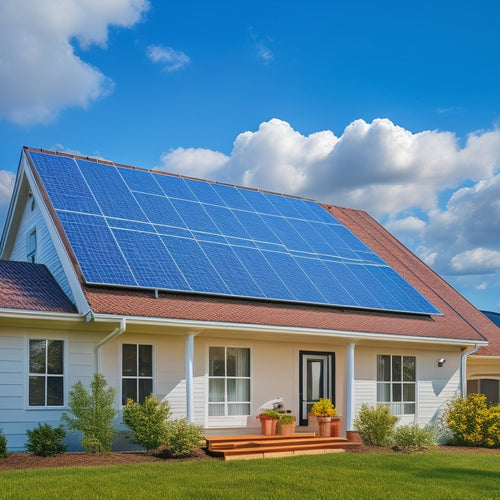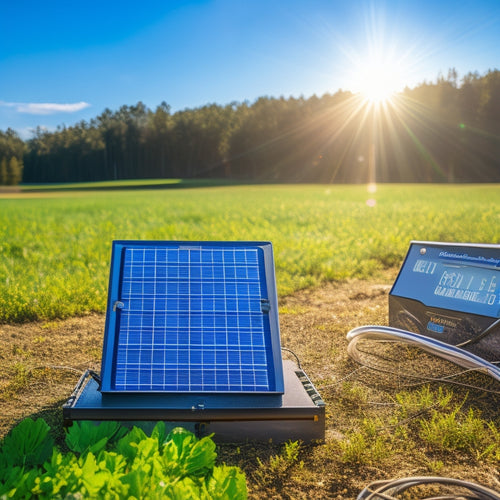
What Affects Inverter Efficiency in Renewable Systems?
Share
When it comes to enhancing your renewable system, you'll want to evaluate the factors that impact your inverter's efficiency. Your inverter's design and technology, component quality, and operating temperature and climate all play a role. Input voltage and power fluctuations, DC to AC conversion efficiency, and system sizing and configuration are also key factors. Additionally, maintenance and monitoring practices can make or break your system's performance. By understanding how these elements interact, you can reveal the full potential of your renewable energy system and maximize its efficiency - and there's more to investigate on how to achieve that ideal performance.
Overview
- Inverter design and topology significantly impact efficiency, with advanced designs enhancing power density and reducing costs.
- High-quality components increase inverter efficiency, typically above 95%, and reduce thermal stress, while poor assembly leads to defects and failures.
- Operating temperature and climate conditions affect inverter performance, with high solar radiation and ambient humidity influencing efficiency and thermal management.
- Input voltage stability and power fluctuations impact inverter performance, with deviations from nominal voltage requiring adjustments and reducing efficiency.
- Proper system sizing and configuration, including component interactions, are critical to preventing capacity mismatches and ensuring optimal inverter efficiency.
Inverter Design and Technology
Designing an efficient inverter is important in renewable systems, as it directly impacts the overall performance and reliability of the system.
You'll need to take into account various inverter topology types, each with its strengths and weaknesses. Recent power electronics advancements have led to more efficient and compact designs, such as those utilizing advanced design, which enable significant power density enhancements for efficient energy conversion and lower costs.
Additionally, real-time monitoring and control capabilities allow for granular control over production and consumption, while AI & machine learning adapt to environmental changes for maximum energy harvest.
Optimizing control algorithms is also essential, as it enables you to fine-tune the inverter's operation and maximize energy harvest.
Additionally, you must guarantee compliance with grid interconnection standards and implement effective thermal management strategies to prevent overheating.
Reliability testing methods and software integration solutions can help identify and address potential issues.
Component Quality and Durability
When selecting components for your inverter, you're building the foundation of a reliable renewable system, and compromising on quality can have far-reaching consequences.
The quality of component materials greatly impacts inverter efficiency. High-quality inverters with high power conversion efficiency, typically above 95%, can minimize energy losses and maximize solar panel output Advanced Features of Inverters.
For instance, using high-temperature-rated components can reduce thermal stress, increasing overall system reliability.
Manufacturing processes also play an essential role, as poor assembly and testing can lead to defects and premature failures.
You should opt for components from reputable suppliers that adhere to rigorous quality control standards.
Operating Temperature and Climate
In harsh outdoor environments, your inverter's performance hinges on its ability to operate within a specified temperature range. Temperature extremes, seasonal variations, and geographical location all impact your inverter's efficiency.
In regions with high solar radiation, your inverter may overheat, reducing its performance. Ambient humidity and wind speed also play a role, as high humidity can lead to condensation and wind can either cool or heat your inverter. Effective thermal management is vital to mitigate these environmental factors.
Furthermore, careful selection of solar panels off-grid systems and load calculations are essential to guarantee the overall energy efficiency of the system.
By understanding the climate and environmental conditions of your installation site, you can select an inverter that's designed to thrive in those conditions, guaranteeing peak performance and efficiency.
Consider the specific challenges of your location to get the most out of your renewable energy system.
Input Voltage and Power Fluctuations
Optimize your system's performance by understanding how input voltage and power fluctuations impact your inverter's efficiency.
Input voltage stability is essential, as fluctuations can lead to power quality issues that reduce your inverter's performance. When the input voltage deviates from the nominal value, your inverter must adjust its operation to compensate, which can decrease its efficiency.
Power quality issues, such as voltage sag, swell, or harmonic distortion, can also affect your inverter's performance. To mitigate these issues, make certain your system is designed with a stable input voltage and implement measures to maintain power quality.
DC to AC Conversion Efficiency
Converting DC power to AC power is a critical function of your inverter, and its efficiency during this process considerably impacts your renewable energy system's overall performance.
When your inverter performs this conversion, you'll encounter conversion losses, which reduce the overall efficiency of your system. These losses occur due to the inverter's internal resistance, switching losses, and other factors.
Additionally, waveform distortion can also affect conversion efficiency. This distortion happens when the inverter's output waveform deviates from a perfect sinusoid, leading to increased losses and heat generation.
You need to carefully select an inverter that minimizes these losses and distortion to guarantee peak performance and efficiency in your renewable energy system.
System Sizing and Configuration
You'll want to carefully consider system sizing and configuration to avoid capacity mismatches that can reduce inverter efficiency.
When system components are mismatched, it can lead to underutilization or overloading, resulting in decreased performance and efficiency.
Additionally, component interaction effects, such as impedance mismatches, can also impact inverter efficiency and overall system performance.
System Capacity Mismatch
Within renewable energy systems, a common pitfall lies in system capacity mismatch, which arises from improper system sizing and configuration. This mismatch occurs when the inverter's capacity doesn't align with the load demand or available energy source. As a result, you might experience reduced inverter efficiency, increased energy losses, and even system downtime.
| System Component | Capacity | Impact on Inverter Efficiency |
|---|---|---|
| Solar Panels | Oversized | Reduced inverter efficiency due to excessive DC power |
| Load | Undersized | Inverter operates below ideal capacity, reducing efficiency |
| Grid Connection | Oversized | Inverter operates at partial load, reducing efficiency and increasing losses |
To avoid system capacity mismatch, you should carefully assess your load demand, available energy source, and grid integration requirements to guarantee ideal system sizing and configuration.
Component Interaction Effects
Optimizing system sizing and configuration is crucial to preventing capacity mismatch, as interactions between components can greatly impact inverter efficiency.
When you design a renewable system, you must consider the component collaboration and interaction interactions. If you don't, you may end up with inefficient energy conversion.
For instance, oversizing or undersizing components can lead to reduced inverter efficiency, increased energy losses, and higher operational costs.
You must guarantee that each component is correctly sized and configured to work harmoniously with others.
Maintenance and Monitoring Practices
Two critical aspects of guaranteeing inverter efficiency in renewable systems are regular maintenance and continuous monitoring practices.
You need to prioritize preventive maintenance to identify potential issues before they affect performance. Performance monitoring through routine inspections and diagnostic tools helps you detect anomalies and troubleshoot problems efficiently.
Implementing maintenance schedules and keeping track of system upgrades guarantees that your inverter operates at peak levels. Employ monitoring software to analyze performance data, identify trends, and make data-driven decisions.
Frequently Asked Questions
Can Old Inverters Be Upgraded for Better Efficiency?
You can upgrade old inverters for better efficiency by leveraging advancements in inverter technology, which enable efficiency upgrades through hardware or software modifications, allowing you to enhance performance and reduce energy losses without replacing the entire system.
How Do Birds and Animals Affect Inverter Performance?
You traverse the renewable energy terrain like a hawk scanning for prey, but bird droppings and animal interference can be silent predators, corroding your inverter's efficiency and crippling your system's performance, so keep a watchful eye out for these hidden threats.
Is Inverter Efficiency Affected by Nearby Radio Frequencies?
You might wonder if nearby radio frequencies impact your inverter's efficiency, and the answer is yes, radio frequency interference can affect it, compromising electromagnetic compatibility and reducing performance, so it's essential to guarantee proper shielding and filtering.
Do Inverters Work Efficiently With Low-Quality Solar Panels?
You carefully curate your clean energy setup, but can low-quality solar panels cripple your inverter's efficiency? Yes, inferior panel quality is an efficiency factor, as it can lead to reduced power output, hindering your inverter's ability to operate at its best.
Can Inverters Be Used With Other Renewable Energy Sources?
You can seamlessly integrate inverters with various renewable energy sources, leveraging inverter compatibility to access efficient renewable integration, as they're designed to work harmoniously with wind turbines, hydro power, and biomass systems, giving you the freedom to choose your energy mix.
Ready to Buy
As you maneuver through the complex terrain of renewable systems, it's essential to acknowledge that inverter efficiency is a delicate balancing act. A concert of factors - from design and component quality to operating conditions and system configuration - must harmonize to optimize performance. By recognizing and addressing these complexities, you can orchestrate a more efficient, reliable, and sustainable energy future.
Related Posts
-

Cost of Solar Panel Installation
You can expect to pay between $15,000 and $30,000 or more for a typical solar panel installation, depending on the sy...
-

Designing a Green Roof for Maximum Energy Efficiency
Designing a green roof for maximum energy efficiency involves several key strategies. Start by selecting native, drou...
-

Choosing the Right Solar Power Charge Controller
Choosing the right solar power charge controller is crucial for maximizing energy efficiency and extending battery li...


